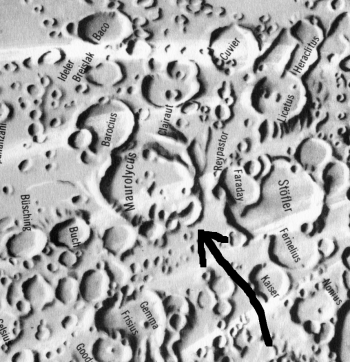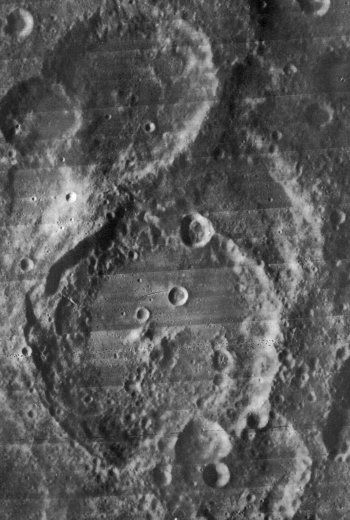Date: Tue, 19 Sep 2000 10:33:54 -0700 From: David Kingsley Subject: Interesting Maurolycus ray
I set up my Starmaster 7 inch Dob last night in Stanford, CA and enjoyed a night of star hopping, open clusters, double stars, and the moon, Jupiter, and Saturn. The terminator of the waning gibbous moon was near the pair of Maurolycus and Barocius. Barocius is located further east, and this ruined crater almost entirely buried in darkness. Its southern wall was still high enough to catch the light of the setting sun however, creating a beautiful bright hemicircle projecting into the black void. This half ring of light fused with the bright rim of the immediately adjacent Maurolycus further west. The combined rims made a pretty reversed S of light, like a letter S scrawled backwards in chalk by a child just learning to write.
Maurolycus itself was spectacular. The crater has a complex shape created by a shared wall with another crater further south. The inner eastern wall looked deep and terraced, lit by the setting sun. Most of the floor was pitch black. However, a central mountain in the middle of the floor was still brightly lit. And as a beautiful bonus, a thin bright ray of light projected in a straight line from this central peak across the dark floor of the crater towards the east. The illumination of the central peak, and this pencil of light, appeared to be created by sunlight coming through an obvious small notch in the high western wall of the crater. In addition to the illuminated central peak and pencil like ray, a single pin-prick like point of light could also be seen on the eastern shadow side of the peak, south of the obvious ray. The overall effect was like an island lighthouse in the middle of a dark ocean, with a search light projecting like a beam across the blackness of the ocean
I first observed this effect around 1:10 am (8:10 Universal time on September 19th). Over the next hour, the ray was maintained, though a few dark breaks began to appear within the ray as the sun set lower and lower on the moon. Meanwhile, the reverse S shape created by the illuminated crater rims was also slowly changing. As the sun set lower and lower on the moon, the semicircle of light created by Barocius began to break up into smaller patches of light and dark along the arc. The top of the child's backwards S thus looked like it was being slowly erased in segments from the blackboard of the moon. I went back and forth between this and other lunar views, enjoying subarcsecond seeing that allowed magnifications between 250 and 350 for much of the time. I shut down about 2 am, the lighthouse still projecting across the crater, and the moon hanging suspended in a beautiful triangle between Jupiter and Saturn.
I haven't seen any mention of the sunset appearance of Maurolycus/Barocius or this ray various lunar sites on the web. I would be interested to hear if anyone else has observed or photographed this area around similar illumination conditions. There are lots of sunrise and sunset effects on the moon, but this one was pretty enough that I would like to see it again.David Kingsley
Maurolycus, +180 -633. Another great formation with lofty walls, and which has encroached on an older object on the south; the border here being broken by a crater, A. What remains of this ancient ring is very rugged. Another ruined ring may be traced on the north-east and contains some craters. This ring has itself been encroached upon by another , which abuts on the wall of Faraday. other imperfect rings exist on the west, and also on the floor itself, the largest of these rings being defined by the mountain group north of the center, curved ridges and a chain of three craters, M. On the inner north slop are two horse-shoe-shaped formations; farther west are two craters, R. South of this is another ruined ring. The inner west slope of the partial ring on the south contains some little bays, probably ruined rings. In addition to the massive central mount group there are several craters, the largest, C, lying between the mountains and the crater A. The outer west slope contains a valley and a short cleft traverses the floor of the ancient ring outside the north-east wall. - Wilkins & Moore, The Moon, Faber and Faber Ltd., 1955

